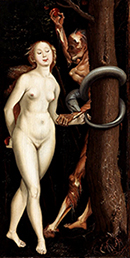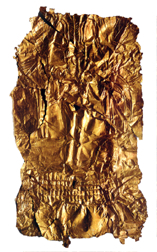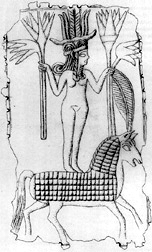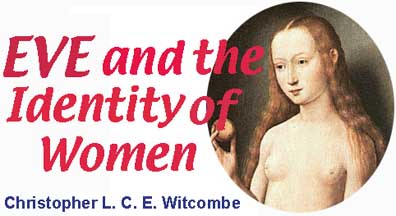|
||||
|---|---|---|---|---|

Eve, the Serpent, and Death
|
6. The Old Testament, Women & Evil
The identification of women with evil had already been established in the Old Testament.
It is important to understand that the story told in Genesis about Eve and the serpent has a larger religious and political context which is the real historical struggle waged by the prophets of Yahweh and the indigenous Canaanite cult of Baal. Baal, who appears to have arrived in Canaan with the Phoenicians, was the son and consort of the Mother Goddess Asherah.
Baal was primarily a fertility god and appears not only in the form of a man and a bull (like his father 'El), but also in the form of a serpent. By stressing through these forms his potency and virility, Baal represents the masculine element, and serves as the fertilizing, life-giving, and life-renewing aspect through whom the Mother Goddess fulfills her functions.
The name Baal (ba'al in Hebrew) means "lord" and was an appellation applied to various manifestations of the god which were referred to in the plural as Baalim. It is apparent that in early times the Israelites worshipped Baal as the true God.
Initially the association was with Baal's father, the Canaanite god 'El, with whom Yahweh was closely related. It is has even been suggested that like 'El, Yahweh, too, had as a consort the goddess Asherah.
As the cult of Yahweh developed, it drew on the myths of Baal. For example, the language used in the earliest poetic sources in which Yahweh is depicted as a divine warrior manifest is borrowed almost directly from Canaanite descriptions of the theophany of Baal as storm god.
However, as the adherents of the Yahwist sect (or the "Yahweh-alone party" as one scholar has called them) engaged in the struggle to establish Yahweh as the one true God, Baal became the enemy of Israel. Baal and the Baalim were represented as false pagan gods and the cult associated with idolatry.
However, it is clear from the Old Testament that the cult of Baal remained popular and was not easily suppressed. The overarching narrative of the Old Testament is the struggle of the Yahwists against Baal for religious dominance in Israel. Time and again the preexilic biblical prophets admonish the Israelites for worshipping Baal.
Although the impression the prophets wish to convey is one of relapse from Yahwism, it is not difficult to discern the fact that the cult of Baal was well-established and widespread in ancient Palestine. In this light, much of the Old Testament can be read as an extended Yahwist propaganda tract against Baal. The tactic adopted by the Yahwists in their efforts to defeat Baal was to demonize the cult and to represent Baal as an evil god, a demon hostile to humankind.
In the story of the temptation and fall in Genesis 3, Baal is represented in his potent serpent form and exposed as a seducer and deceiver and as Yahweh's evil adversary.
A clear hint to how the Genesis story should be read is found in the writings of Hosea (Osee) the theme of which, contained in the metaphor of the Israelites behaving like an unfaithful wife and "playing the harlot", is the desertion of Yahweh by the Israelites and their seduction by the Canaanite Baal.
In Hosea's story can also be discerned some essential features of the cult of Baal which, when combined with other brief references found scattered through the Old Testament, reveal, at least in the eyes of the patriarchal Israelites, that it was strongly associated with women.
It is also clear that the cult was not principally that of Baal but also that of his mother-consort the goddess Asherah (or Ashteroth, or Astarte). In Judges 2:13, 3:7, 10:6, and 1 Samuel 7:4, 12:10, the Israelites are accused of abandoning Yahweh and "serving the Baals and the Asherahs."
 
Canaanite Goddess (Astarte-Ashtoreth?)
The cult itself was evidently celebrated in high places, on the tops of hills and mountains, where altars dedicated to Baal and carved wooden poles or statues of Asherah (or "the Asherahs"; in the past "Asherah" has also been translated as "grove", or "wood", or "tree"). There, sacrifices were made, and incense burnt not only to Baal but also to the sun and the moon, the "twelve signs" and to "all the host of heaven" by which is meant all the stars (Hosea 4:13). The latter grouping of moon, twelve signs, and stars all signify Asherah. It seems clear that Asherah and Baal were worshipped together. When King Hezekiah (727-698 BCE) set about destroying cult sites, he "cut down the Asherah and broke into pieces the Brazen Serpent [i.e. Baal] which Moses had made" (II Kings 18:4). That it was principally women who were involved in the cult of Baal/Asherah is made clear from passages in Jeremiah 44. When threatened with destruction for not following Yahweh, it is the women who respond saying that
(Jeremiah 44:17)
The women explain that they have resumed burning incense and pouring libations because when they stopped they have since suffered deprivation and destruction. They also point out to Jeremiah that their activities are supported by their husbands (Jeremiah 44:19). The cult evidently had adherents also among high-ranking women, such as Maacah, the mother of King Asa of Juda, who was clearly some sort of priestess of Asherah and played a role in cult rituals (I Kings 15:13). King Asa, however, removed her from her position as priestess and physically destroyed the cult centre, breaking and burning the sacred wooden pole or statue of the goddess. In the Yahwists' scathing condemnation of the cult of Baal/Asherah, women are frequently singled out and blamed for leading Israelites astray. Solomon, for example, has his heart "turned away" from Yahweh by women (I Kings 11:3) and he worships "Astarthe the goddess of the Sidonians" (I Kings 11:5). The Phoenician city of Sidon was a centre for the worship of Asherah. In another case, Jezebel, the daughter of Ethbaal, king of the Sidonians (Ethbaal, of course, is a cognate of Baal, as is Jeze-baal), caused her husband, King Ahab (873-852 BCE), to worship Baal and Asherah (I Kings 16:31-33). Accordingly, Jezebel has been condemned ever since as a wicked woman. The Baal-Asherah cult, therefore, was demonized not only because it was perceived as inimical to Yahwism, but also because its principal adherents were women. This may explain some important features of the Genesis story. First, it is noteworthy that in the scene of the temptation, the serpent approaches not Adam, as you might expect, but Eve. Although this is usually explained by the "fact" that Eve, being a woman, was more weak-willed than Adam and therefore more susceptible to temptation, it is more believably the case that the narrator of the story was witnessing an already established association between the serpent and the woman. The point of Genesis 3 is to make this otherwise obvious link but then to show how the serpent in fact deceived and betrayed the woman. Indeed, to underscore this the woman is actually made to say "The serpent deceived me and I ate" (Genesis 3:13). The narrator then cleverly has Yahweh punish the serpent for deceiving the woman, but at the same time uses it as an opportunity to drive a wedge between the serpent and the woman with a curse putting everlasting "enmity" between them and their offspring. The story successfully alienates the woman from her long-time ally, the serpent. The curse metered out to Eve as punishment for her listening to the serpent is also interesting in this respect. Yahweh tells Eve that he "will make great your distress in child-bearing; in pain shall you bring forth children." This is, when all is said and done, a curious punishment for disobedience. It makes sense, however, when it is placed within the context of the Baal/Asherah cult. Cults which focused on a Mother Goddess were attractive to women because in most instances they addressed the concerns of women. Among these concerns would be sexual health ranging from fertility in general to particular matters such as menstruation, conception, pregnancy, child-birth, breast-feeding, and infant care (see also "Snake Charmers" in The Minoan Snake Goddess). Significantly, as in the case of Baal/Asherah, the serpent, as an aspect of the Mother Goddess, was identified with health and healing. Especially in an age when child-bearing was potentially life-threatening to the mother, cults associated with the Mother Goddess were a source of support and consolation. A Hebrew incantation text from the 7th century BCE, for example, seeks the help of the goddess Asherah for a woman in childbirth. The punishment Yahweh enacts on Eve is a slap in the face of one of the principal functions of the Mother Goddess which is to protect women in child-bearing. In a logic similar to that used by Jeremiah 44 (see above), who tried to explain to the women that the deprivation and suffering among the Israelites was Yahweh's punishment for their continued adherence to the cult of Baal/Asherah (whereas the cult followers believed the opposite, that their suffering was the result of their neglect of cult practices), Genesis argues in effect that, contrary to the belief that women found help and relief in childbirth through the Baal/Asherah cult, the distress of child-bearing and the pain of childbirth in fact is the result, in the form of Yahweh's punishment, of their (Eve's) continued adherence to the cult, indicated by Eve's listening to the serpent and disregarding the orders of Yahweh. If the Baal-Asherah cult was associated primarily with women, an additional reason for the Yahwists' condemnation of it may also have been that it existed in and was perhaps supported by non-patriarchal social institutions. Hosea clearly associated the Baal-Asherah cult with promiscuous sexual behaviour among women ("your daughters play the harlot, and your daughters-in-law are adulteresses" 4:13) which may be a reflection of his patriarchal distaste of the attitudes towards sexual relations found among matrilineal societies (see Matriliny in the Aegean Bronze Age for further discussions of matriliny).
The point that needs to be stressed is that the "holy war" waged by the Yahwists against the cult of Baal/Asherah was not simply or only a conflict between two religious groups but was also a fight conducted by the masculine against the feminine. This conflict would perhaps be of little consequence were it not for the fact that its values have been transmitted down through the centuries and have contributed significantly to the shaping of Western ideas and attitudes. As Anne Baring and Jules Cashford point out [see BIBLIOGRAPHY], it established a "paradigm of opposition" not just of men against women, but of good (men) against evil (women). And so, while it may be argued that analysis of the original context of the Genesis story outlined above would not have been generally available during the Christian period, the basic "truth" of the story identifying women with evil would have been all too familiar as part of the patriarchal Judaeo-Christian tradition.
7. EVE & LILITH
An earlier version of this essay appeared originally in Images of Women in Ancient Art
Copyright © (text only) 2000. Christopher L.C.E. Witcombe
|
|||


